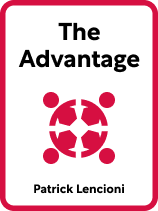

This article is an excerpt from the Shortform book guide to "The Advantage" by Patrick Lencioni. Shortform has the world's best summaries and analyses of books you should be reading.
Like this article? Sign up for a free trial here.
What is The Advantage by Patrick Lencioni about? What are the main takeaways of the book?
The Advantage by Patrick Lencioni presents a straightforward method to establish organizational health and become a powerhouse company in your industry. Further, he defines organizational health and why it’s so important for a successful business.
Read below for an overview of Patrick Lencioni’s book The Advantage.
The Advantage by Patrick Lencioni
Many leaders spend large sums on marketing and technology trying to obtain a competitive advantage for their business. However, Patrick Lencioni explains that the biggest advantage they can gain is actually free and already within their reach: organizational health. Without organizational health, even the savviest industry leaders will find themselves failing to reach their full potential. In The Advantage, Patrick Lencioni lays out a straightforward plan to establish organizational health so that your company quickly becomes a powerhouse in its industry.
Lencioni is a consultant who specializes in executive team management and organizational health. He’s also the author of numerous books on business and team management, including The Five Dysfunctions of a Team, Death by Meeting, and The Ideal Team Player. Lencioni began working in management and organizational health after realizing that struggling corporate leaders were wasting their time on things like strategy, finance, and marketing when their real problem was poor management. Since then, he’s dedicated himself to presenting a straightforward and actionable way for organizations to improve their management, cohesiveness, and efficiency—in other words, their organizational health.
The Organization of Lencioni’s The Advantage
In The Advantage, Lencioni explains that there are four disciplines that create a healthy organization:
- A unified leadership team
- Clear and consistent goals and standards
- Regular communication with employees about goals and standards
- Human systems that align with organizational goals and standards
Each of these four disciplines has its own chapter. Then, in two more chapters, Lencioni discusses the importance of meetings and leaders.
This organization is partially effective because healthy organizations must have a strong foundation—a leader who understands the importance of organizational health, a unified leadership team, and clear and consistent goals and standards that bring structure to the organization. Therefore, it makes sense to discuss these factors first.
What Is Organizational Health and Why Is It Important?
Lencioni’s definition of organizational health encompasses two main factors. First, the organization’s goals and standards are clear, consistent, and regularly communicated to everyone in the organization. Second, individuals and groups align with the organization’s standards and are dedicated to the organization’s goals. Factor one is necessary for factor two to exist. When organizations implement these two factors of organizational health, Lencioni says they’ll be highly effective.
Why Is Organizational Health Important?
Lencioni explains that organizational health is important for two reasons. First, it enables organizations to meet their full potential. For strategies, financial investments, goals, and solutions to be effective, everyone must work towards the same overarching goals, uphold the same behavioral standards and values, and understand their role. Without these factors, even organizations with the best strategy, marketing, finances, and technology (what Lencioni calls intelligence) will fail to meet their full potential. Their progress will be hindered by politics and conflicting goals among leaders and departments. Further, work will lack meaning, and employee turnover will be higher.
Second, organizational health will be your invisible superpower because many leaders overlook it—they think it’s too intangible to focus on and achieve, are too impatient to complete the process of developing health, or don’t believe in its impact. If you’re dedicated, persistent, and disciplined enough to see it through, organizational health will give you the competitive advantage that others are too blind to see.
(Shortform note: Research supports Lencioni’s claim that organizational health will give your company a tangible advantage that’s overlooked by competitors. The McKinsey group found that over the course of a decade, companies that improved their organizational health reported an 18% increase in earnings and a 10% increase in returns to shareholders (TRS). For context, the average company on the S&P 500 (an index that tracks the stock performance of 500 large companies listed on exchanges in the United States) showed only a 7% average increase in earnings and a 9% average increase in TRS.)
How Do You Create Organizational Health?
Lencioni’s process to achieve organizational health can be broken into four main steps:
- Create a unified and efficient leadership team that runs the organization.
- Establish clear and consistent organizational goals and standards.
- Achieve employee alignment with and dedication to the organization’s goals and standards.
- Maintain organizational health by having effective meetings.

———End of Preview———
Like what you just read? Read the rest of the world's best book summary and analysis of Patrick Lencioni's "The Advantage" at Shortform.
Here's what you'll find in our full The Advantage summary:
- How the biggest business advantage you can gain is free and within your reach
- How to create an effective leadership team
- How to maintain organizational health with effective meetings






